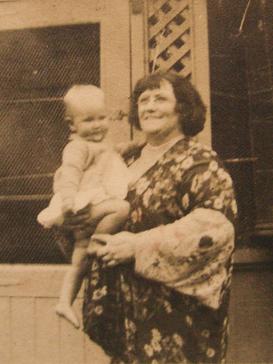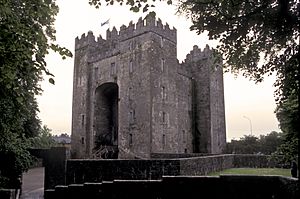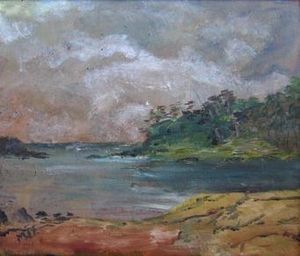Myra Juliet Farrell facts for kids
Quick facts for kids
Myra Juliet Farrell
|
|
|---|---|

Myra Juliet Farrell in 1939 with her grandchild Jennifer
|
|
| Born |
Maria Julia Welsh
25 February 1878 County Clare, Ireland
|
| Died | 8 March 1957 (aged 79) |
| Other names | Myra Juliet Welsh; Myra Juliet Taylor |
| Occupation | inventor,painter |
Myra Juliet Farrell (born February 25, 1878 – died March 8, 1957) was an amazing Australian inventor and artist. She was also known as Myra Juliet Welsh and Myra Juliet Taylor.
She was born in County Clare, Ireland. When she was a child, her family moved to Australia. She grew up in Broken Hill and later lived in Mosman, Sydney. Myra was very clever and invented many things. She had over 24 patents for her inventions! These included everything from a special military barricade to a simple press stud that didn't need sewing.
Contents
Myra's Early Life

Myra Farrell was born in Ireland on February 25, 1878. Her birth name was Maria Julia. She was one of six children. Her family owned land in County Clare.
In the 1880s, Myra's family moved to Australia. Her mother, Harriett Welsh, was born there. They arrived in Adelaide and traveled to Broken Hill. Myra's parents started a school in Silverton, a new town nearby. Later, they moved to Broken Hill and opened St Peter's School, where Myra studied. Her mother was a very respected music teacher.
How Myra Invented Things
Myra's Creative Process
Myra started inventing at a young age. When she was just ten, she thought of a self-locking safety pin. She later explained how she came up with her ideas.
Myra would first notice something that was needed. Then, she would think about it and sleep on the problem. She said that in her dreams, she would see the complete solution. She would even see how the invention should be built!
She would wake up and write down all the details. Sometimes, she wrote on bed sheets or even the wall! Her dream-writing was always from right to left. In the morning, she would copy it correctly using a mirror. Myra also drew all the detailed plans and made models for her patent applications.
Useful Inventions
Myra's first patent was for a sewing tool. It helped transfer a small skirt pattern from a book directly onto fabric. She invented many useful things for the home. One was a folding clothesline, perfect for small apartments.
She also created health aids. These included a special corset for people with scoliosis (a curved spine). She also made a brace for hernias. Myra even invented a device for a facelift using simple mechanics. She also developed a sling for carrying babies. This was before baby carriers were common in Western countries.
Myra also invented things for farms. These included a machine to pick and pack fruit. She also made a device to weigh wheat. She invented the press-stud that you can attach without sewing. She also created the folding hood for a pram. By 1915, Myra had 24 patented inventions!
Special Medications
When Myra lived in Broken Hill, she had serious breathing problems. She dreamt of a special formula for an inhaler. This inhaler helped clear mucus, reduce swelling, and promote healing. She made tablets from this formula. People would burn them in a special device and breathe in the fumes.
Myra met William Taylor, who was very ill. She treated him with her inhalant. He got much better, and they married in 1906. He lived for six more years. Later, her product was sold as "Membrosus." Myra also had great success with an ointment called "Myra's ointment." She used it to help a woman with a rare skin disease.
Military Inventions
During World War I, Myra worked on a special barricade. This barricade could stop bullets and lessen the impact of shells. The Australian Department of Defence looked at her plans. It's not known if her barricade was ever used.
Around the same time, she developed a light that could shine very far. She first thought it could be used for advertising. But the military also took her plans and her prototype. A family story says the light was tested from North Head in Sydney Harbour. It caused confusion for a ship at sea, which thought it was the South Head lighthouse!
Myra's Personal Life
Myra Farrell, also known as Mrs. Taylor, was described in a newspaper article. It said she was a kind and friendly person. She was fair-skinned and plump, with blue eyes. She had a soft, slow voice.
Myra married twice. First, she married William Taylor. They had two children, Lavie and William. After William's death, she married William George Farrell. They had a son named George, who became a violinist. Myra lived in different places, including Western Australia and Bondi in Sydney. She spent her later years in Mosman.
Besides inventing, Myra loved to paint. She learned from an artist who painted stage scenery. Her paintings had a broad, Impressionist style with bright colors. All her known paintings are small landscapes.
Myra was also interested in Theosophy, a spiritual philosophy. She helped pay for a grandstand at Balmoral Beach. This was to see the arrival of Krishnamurti, a spiritual teacher. She also supported William Lane, who wanted to create an ideal community in Paraguay.
Myra was known for being a bit unusual, even in her family. One funny story is that she kept the foot of an Egyptian mummy on her mantelpiece. Her housemaid refused to touch it! It was accidentally thrown out with the garbage. This even led to a police investigation when the garbage collector found it!
Myra Farrell passed away at her home in Mosman on March 8, 1957.
What People Said About Myra
Myra Farrell was called a "genius" by the Geraldton Guardian newspaper.
The Western Age newspaper in Dubbo wrote:
"That common saying 'A prophet has no glory in his own land' was never more true than for Mrs. Myra Juliet Taylor. This amazing lady could truly be called the most talented woman in Australia. Yet, she lives among us, unknown, almost hidden."
See also
 In Spanish: Myra Juliet Farrell para niños
In Spanish: Myra Juliet Farrell para niños


